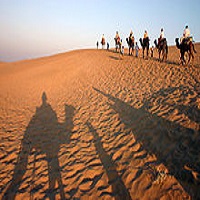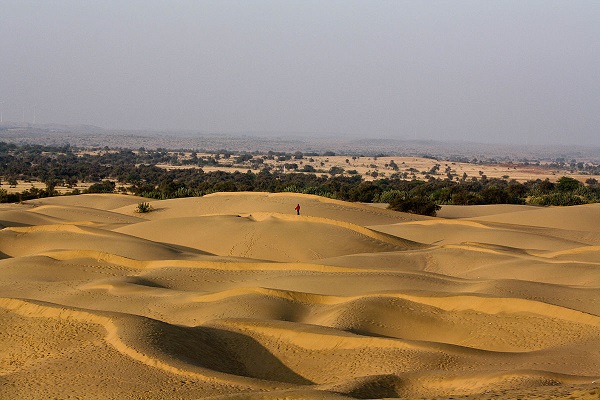The Thar Desert is the 17th largest subtropical desert of the world lies in the northwestern parts of the Subcontinent. It covers an area of 77 thousand square miles, 200,000 square kilometers approximately. The desert is spread through Rajasthan, Gujrat, and Haryana in India and Sindh and Punjab in Pakistan. The coordinates are 26’59’04 in the north and 71’00’06 in the east.
About 15 percent of the desert is situated in Pakistan, while the remaining 85 percent of the desert is located in India, where Rajasthan covers 60 percent of the desert. Thar continues to the Pakistani province of Punjab as desert Cholistan. This article carries all the information, including Thar Desert History.
| Title | Description |
|---|---|
| Information | |
| Location: | between India and Pakistan |
| Countries: | India, Pakistan |
| State India : | Rajasthan Haryana Punjab Gujarat |
| State Pakistan: | Pakistan: Sindh Punjab |
| Name: | Thar Desert |
| In Urdu: | صحرائے تھر |
| Nickname: | Great Indian Desert |
| Type: | world’s 17th largest desert |
| Coordinates : | 26°59′04″N 71°00′06″E |
| Decimal: | 26.984444, 71.001667 |
| Geo URI : | geo:26.984444,71.001667 |
| UTM : | 42R 698647 2986287 |
| Details | |
| Province: | Sindh Punjab |
| Biome : | Desert |
| Plant : | thorn scrub forest |
| Animal : | Chinkara |
| SCIENTIFIC CODE: | (IM1304) |
| SIZE: | 92,200 square miles |
| STATUS: | Vulnerable |
Table of Contents
Thar Desert History
State of Jaisalmer
The history goes back to the state of Jaisalmer, who ruled the dynasty of Bhati. The rulers of Bhati ruled over many regions, including Afghanistan (Ghazni), India (Hanumangarh), and Pakistan (Lahore, Sialkot, Rawalpindi).
The reign of Jailsalmer started reducing when the Hindu Shahis of Kabul united with Bahti rulers in order to defeat Ghazni Turkic rulers, but they were defeated by Ghazni rulers in 997, and the dynasty of Bhati moved toward Jaisalmer through Multan and Cholistan where the Dera of Rawal was built by Deva Raja.
Foundation of Jaisalmer
Maharawal Jaisal Singh founded Jaisalmer as the capital of the state in 1156, which became the colony of British Rulers in 1818. Tax on caravans was the major source of Jaisalmer’s income which was demolished when the trade was started through the port of Bombay. The scarcity of many things in Jaisalmer resulted in the worst situation losing livestock upon which the income of the state relied.
Partition of Subcontinent
After the partition of the subcontinent, the division of Thar took place, and between the years of 1965-1971, and round about three thousand and five hundred Muslims who were living in the Indian part of the desert were migrated to Pakistan. Thousands of Hindus living in the Pakistan part of the desert were migrated to the Indian part of the desert.
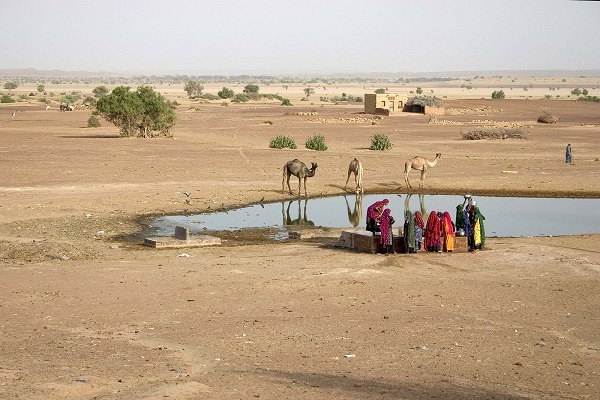
Population
The Desert is considered to be the world’s most populated desert, with a population density of 84 persons per square kilometer. The inhabitants contain Hindus, Sikhs, Jains, and Muslims in India, while in Pakistan, it comprises both Hindus and Muslims. In Rajasthan, about 40 percent of the population lives in That Desert. The main occupation of the inhabitant is livestock and agriculture.
Area
The total area is 200,000 square kilometers, among which 40 percent of the area is covered by the territory of Pakistan which the remaining 60 percent of the desert lays in India, mostly in Rajasthan.
Climate
The climate is hot and dry. The highest recorded Thar Desert temperature is 43 degrees centigrade, while the lowest recorded temperature is 8 degrees centigrade with a rainfall of 4 inches to 100mm annually.
Religion
Most of the population is the followers of Hinduism. According to a survey in 2017, seventy percent of the population is Hindus, while the remaining thirty percent of the population is Muslims.
Thar Desert Culture
The inhabitant of the Cholistan, who belong to different castes and sects, has a rich tradition, culture, folk tales, and heritage, music, and dances festivals. Hindus of the desert celebrate Dewali with full zeal while the Muslim community of the region celebrates Eid –ul- Fitr and Eid-ul- Adha once a year.
Ancient Literature
Rig-Veda River, named as the River of Sarasvati, was mentioned in the ancient text of Hindus. The Rig-Vida hymn mentioned the River Saravasti between Sutlej and Yamuna, which was dried up and mentioned by Vedic texts like Mahabharata. The Vedic text mentioned the region as a forest named Kamyaka, which was located on Kuru Kingdom’s boundary.
A lake is also mentioned in the name of Kamyaka in Vedic Texts. The forest of Kamyaka was said to be located in the head/center of the desert near the lake of Trinavindu. A river under the name of Asvanvati was also mentioned by the Hindu book Rig-Veda, but many scholars suggested that Asvanvati and Sarasvati are the same rivers.
Thousands of people living here were shifted to the modern-day Jodhpur and Bikaner during the period of Mahabharata. These regions were called the provinces of Madrajangala and Kurujangala.
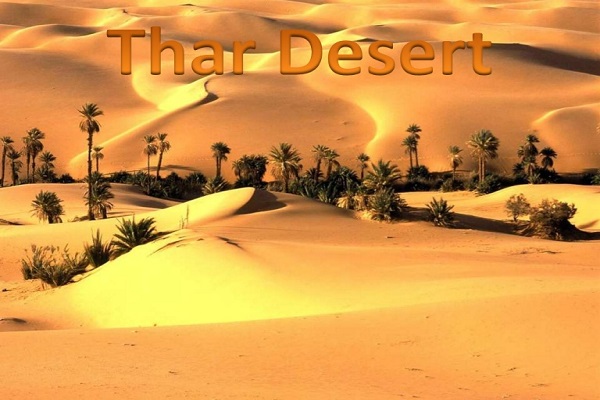
Land
The Desert of Thar has a barren land and low fertility quality. Thar desert is most famous for its special types of trees and vegetables grown due to the scarcity of water. The government of Pakistan is now trying to cultivate different new types of trees in order to decrease the temperature and increase annual rainfall by 200mm.
Furthermore, it has seven different types of soil, including brownish/grey soil (Sierozems), red soil, yellow soil, shallow weathered soil (Lithosols), saline soil, and soft, loose soil (Regosols). Yellow and red soils are found in foothills, while all the other types are found in hills.
Housing and Water
Scarcity of water plays a very important role as the only source of water is the manmade johads or natural tubes. The supply of water is not efficient, and the underground water is mineral dissolved and not fit for drinking. Furthermore, the houses of the people are often made of mud and baked bricks. Every three persons are living in a single room.
The Desert Life
The area of the desert is very dry, dusty, and hot. There are about 800 villages in India and Pakistan living here, are facing a lot of problems. Water is considered to be the main problem of their survival. There is also insufficient food available to them, while access to education is negligible for them. They use to live with their cattle containing camels, sheep, cows, and ox.
Livestock
Some of the best breeds of desert cattle are Nagauri and Sachori (Kankrej). Other livestock of the region include;
- Camel
- Goat
- Sheep
- Buffalo
- Cow
- Oxes
Flora
A special variety of fruits, vegetables, trees, and grasses are grown in rare quantities. Some of them are given below.
Vegetables
- Gum Arabic acacia
- Euphorbia
- Bher
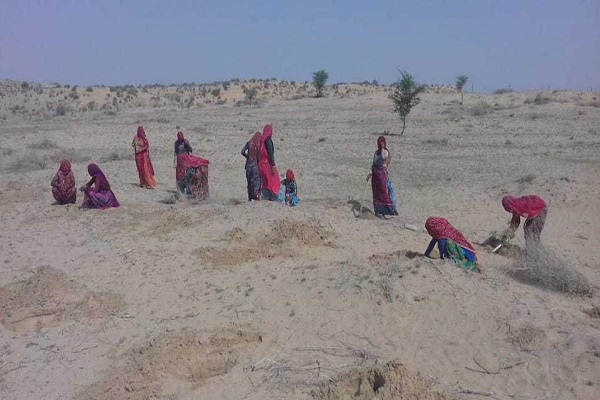
Trees
- Khajri
- Prosopis cineraria
Fauna
It is a home for many species of animals and birds, including the rare ones. Due to the scarcity of water, the rare species are trying to survive. Some of the types of species are given below.
- Blackbuck
- Chinkara
- Lizard
- Snake
- Eagles
- Falcons
- Harriers
- Vultures
- Buzzards
Umerkot
Umerkot is a small town where the Great Mughal emperor Akbar was born. The town is used as a gateway to the other regions of Pakistan from the desert. Most of the people living in Umerkot are Hindus. According to the 2017 census of Pakistan, Umerkot contains seventy percent Hindus, and thirty percent were Muslims. The town contains many schools, shops, offices, and a bazaar where all of the seasonal vegetables and fruits are available.
In Umerkot, most of the uneducated people work for money and to buy daily stuff for their survival. People also come to the town to sell their cattle and to buy the things they need. The government has now constructed many roads to the villages of the desert and started a transport system for the people living there. Buses provide transportation service to the people.
Ramsar and Mithi
Ramsar and Mithi are the two small villages located in the mid of the desert, which has a distance of 25 kilometers from Umerkot. The people use buses to travel to other cities or villages of the province or the entire country. Both of the villages are at a distance of seventy-five minutes from the main town of Umerkot.
Most of the uneducated male members of the society in the entire Thar use to work in Umerkot for money, for which they travel hours to earn and take responsibility for their families. The town of Umerkot facilitates the people of Cholistan in terms of schools, shops, bazaar snd sabzi mandi, etc.
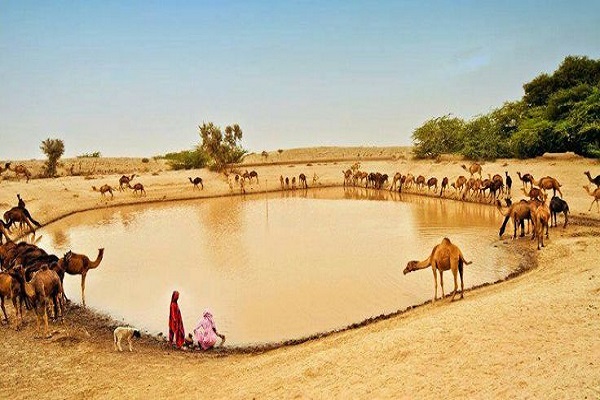
Social Media Handles
https://www.facebook.com/thardesertpk/
